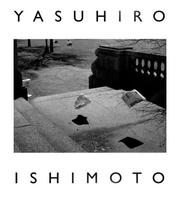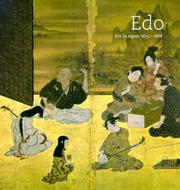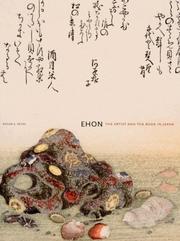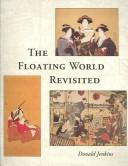| Listing 1 - 10 of 14 | << page >> |
Sort by
|
Book

ISBN: 9780300210491 9780876332634 Year: 2015 Publisher: Philadelphia Philadelphia Museum of Art, in association with Yale University Press
Abstract | Keywords | Export | Availability | Bookmark
 Loading...
Loading...Choose an application
- Reference Manager
- EndNote
- RefWorks (Direct export to RefWorks)
The Kano lineage of painters--the most important in Japan--was established in the late 15th century by Kano Masanobu (1434-1530) and continued for more than 400 years, until the early 20th century. Originally limited to successive generations of the Kano family, it soon developed into a school of professional artists. This is the first and most comprehensive book published outside of Japan to address the Kano painters. Lavishly illustrated, this important volume focuses on the large-scale screens and sliding doors that were designed for the residences of powerful rulers, together with smaller works such as scrolls, albums, and fans. These works-for sites including shogunate residences, Zen temples, teahouses, and homes of wealthy merchants-demonstrate the range of styles that Kano artists employed to suit the tastes of their varied patrons. Essays by leading scholars address the wide range of Kano motifs and styles and also consider the particular influence of Kano Tan'yu (1602-1684). A dictionary of Kano artists' seals and signatures, a type of resource published here for the first time, provides an important reference, as does an appendix of images from the most significant album by Tan'yu. Exhibition: Philadelphia Museum of Art, USA (14.2.-10.5.2015).
Kanō School --- Painting, Japanese --- Seals (Numismatics) --- Japanese painting --- Nihonga --- History. --- J6230 --- J6015.11 --- Japan: Art and antiquities -- painting and drawing -- Chinese schools --- Japan: Art and antiquities -- musea, exhibitions, collections, fairs in North America -- United States --- History

ISBN: 0865591709 9780865591707 Year: 1999 Publisher: Chicago Art institute of Chicago
Abstract | Keywords | Export | Availability | Bookmark
 Loading...
Loading...Choose an application
- Reference Manager
- EndNote
- RefWorks (Direct export to RefWorks)
Although he is a Japanese photographer who has lived in Tokyo for more than 45 years, Yasuhiro Ishimoto received his art education in the late 1940s and early 1950s at the Institute of Design in Chicago, where he studied under Harry Callahan. Ishimoto's photographs of Chicago document a period of profound social, political, and racial change and record the character of the city from its lakefront beaches and downtown streets to its South Side neighborhoods. Ishimoto returned to Japan in 1953 and began a documentation of Tokyo. In his work, Tokyo and Chicago have become sister cities in the personal vision of an artist whose patience as a photographer and tenacity of observation have enabled him to produce the extraordinary body of work evident in such books as Someday Somewhere and Chicago, Chicago. He has also produced two books on Katsura villa, another on flowers, and several others on Japanese subjects.Large as is the range of Ishimoto's tale of two cities, in recent years another side of his sensibility has come to the fore in very subtle studies of rotting leaves, footprints in snow, cloud formations, and wind-ruffled water at his feet. Now 77, Ishimoto is revealing a meditative dimension that has brought him recognition as a "Person of Cultural Distinction" in Japan and serious regard worldwide for his artistic achievements.
Book
ISBN: 0942946014 Year: 1984 Publisher: Oberlin Oberlin College
Abstract | Keywords | Export | Availability | Bookmark
 Loading...
Loading...Choose an application
- Reference Manager
- EndNote
- RefWorks (Direct export to RefWorks)


ISBN: 0300077963 Year: 1998 Publisher: London Yale university press
Abstract | Keywords | Export | Availability | Bookmark
 Loading...
Loading...Choose an application
- Reference Manager
- EndNote
- RefWorks (Direct export to RefWorks)
J6008.60 --- J6015.11 --- Japanse kunst ; Edo periode ; 1600-1868 --- Grafiek ; houtsneden ; Japan --- 7.032.14 --- (069) --- Japan: Art and antiquities -- history -- Kinsei, Edo, Tokugawa, early modern (1600-1867) --- Japan: Art and antiquities -- musea, exhibitions, collections, fairs in North America -- United States --- Kunstgeschiedenis ; Indische en Zuidoost -Aziatische, Sri Lankese kunst --- (Musea. Collecties) --- Exhibitions --- Art [Japanese ] --- Edo period, 1600-1868

ISBN: 1555951163 Year: 1996 Publisher: Worcester New York Worcester Art Museum Hudson Hills Press
Abstract | Keywords | Export | Availability | Bookmark
 Loading...
Loading...Choose an application
- Reference Manager
- EndNote
- RefWorks (Direct export to RefWorks)
paintings [visual works] --- Painting --- prints [visual works] --- Japan --- Exhibitions --- J6212.40 --- J4176.80 --- J4188 --- J4233 --- J6015.11 --- Japan: Art and antiquities -- painting and drawing -- ukiyo-e -- themes and subjects -- women, courtisans, bijin-ga --- Japan: Sociology and anthropology -- gender roles, women, feminism -- history --- Japan: Sociology and anthropology -- night-time entertainment, mizu shōbai, geisha, hostess, mama-san --- Japan: Sociology and anthropology -- social pathology -- prostitution --- Japan: Art and antiquities -- musea, exhibitions, collections, fairs in North America -- United States
Book
ISBN: 9783791350820 Year: 2010 Publisher: München Prestel
Abstract | Keywords | Export | Availability | Bookmark
 Loading...
Loading...Choose an application
- Reference Manager
- EndNote
- RefWorks (Direct export to RefWorks)
Graphic arts --- anno 1800-1899 --- Japan --- Color prints, Japanese --- Impressionism (Art) --- Ukiyoe --- J6015.11 --- J6020 --- J6210 --- Hashirae --- Pillar prints (Ukiyoe) --- Ukioye --- Ukiyo-e --- Genre painting --- Painting, Japanese --- Aesthetics --- Art, Modern --- Modernism (Art) --- Painting --- Post-impressionism (Art) --- Japanese color prints --- Influence --- Japanese influences --- Japan: Art and antiquities -- musea, exhibitions, collections, fairs in North America -- United States --- Japan: Art and antiquities -- Japanese aesthetics (Japonism) --- Japan: Art and antiquities -- painting and drawing -- ukiyo-e --- Exhibitions
Book
ISBN: 0870116509 4770011504 Year: 1984 Publisher: Tokyo Kodansha international
Abstract | Keywords | Export | Availability | Bookmark
 Loading...
Loading...Choose an application
- Reference Manager
- EndNote
- RefWorks (Direct export to RefWorks)
prints [visual works] --- Japan --- Color prints, Japanese --- Color prints --- J6015.11 --- J6212.20 --- Chromoxylography --- Color-etchings --- Painting --- Wood-engraving, Colored --- Engraving --- Prints --- Chromolithography --- Japanese color prints --- Exhibitions --- Japan: Art and antiquities -- musea, exhibitions, collections, fairs in North America -- United States --- Japan: Art and antiquities -- painting and drawing -- ukiyo-e -- themes and subjects -- poetry, literature, surimono --- Color reproductions --- Helen Foresman Spencer Museum of Art --- University of Kansas. --- Spencer Museum of Art --- SMA --- Exhibitions.

ISBN: 0295986247 9780295986241 Year: 2007 Publisher: University of Washington press: New York: New York public library,
Abstract | Keywords | Export | Availability | Bookmark
 Loading...
Loading...Choose an application
- Reference Manager
- EndNote
- RefWorks (Direct export to RefWorks)
Ehon - or "picture books"- are part of an incomparable 1,200-year-old Japanese tradition. Created by artists and craftsmen, most ehon also feature essays, poems, or other texts written in beautiful, distinctive calligraphy. They are by nature collaborations: visual artists, calligraphers, writers, and designers join forces with papermakers, binders, block cutters, and printers. The books they create are strikingly beautiful, highly charged microcosms of deep feeling, sharp intensity, and extraordinary intelligence. In the elegant, richly illustrated Ehon: The Artist and the Book in Japan, renowned scholar Roger S. Keyes traces the history and evolution of these remarkable books through seventy key works, including many great rarities and unique masterpieces, from the Spencer Collection of the New York Public Library, one of the foremost collections of Japanese illustrated books in the West. The earliest ehon were made as religious offerings or talismans, but their great flowering began in the early modern period (1600-1868) and has continued, with new media and new styles and subjects, to the present. Shiohi no tsuto (Gifts of the Ebb Tide, 1789; often called The Shell Book) by Kitagawa Utamaro, one of the supreme achievements of the ehon tradition, is reproduced in full. Michimori (ca. 1604), a luxuriously produced libretto for a No play is also featured, as are Saito- Shu-ho's cheerful Kishi empu (Mr. Ginger's Book of Love, 1803), Kamisaka Sekka's brilliant Momoyogusa (Flowers of a Hundred Worlds, 1910), and many more. Ehon: The Artist and the Book in Japan ends with ehon by some of the most innovative practitioners of the twentieth century. Among these are Chizu (The Map, 1965), Kawada Kikuji's profound photographic requiem for Hiroshima; Yoko Tawada's and Stephan Kohler's affecting Ein Gedicht für ein Buch (A Poem for a Book, 1996); and Vija Celmins's and Eliot Weinberger's Hoshi (The Stars, 2005). The magnificent ehon tradition originated in Japan and developed there under very specific conditions, but it has long since burst its bounds, like any living tradition. Ehon: The Artist and the Book in Japan suggests that when artists meet readers in these contrived, protected, focused, sacred book "worlds," the possibilities for pleasure, insight, and inspiration are limitless. (www;amazon;com)
J6290 --- J0934.10 --- J0942 --- J6200 --- J6015.11 --- Japan: Art and antiquities -- painting and drawing -- type and form -- illustrative works --- Japan: Books and magazines -- libraries, bibliographies, databases, musea, exhibitions, auctions -- antiquarian works --- Japan: Books and magazines -- printing, engraving, duplicating --- Japan: Art and antiquities -- painting and drawing --- Japan: Art and antiquities -- musea, exhibitions, collections, fairs in North America -- United States --- Exhibitions --- Illustration, livre --- Livre --- Livre d'artiste --- Picture books --- Illustrated books --- Illustrators --- Books --- Graphic arts --- Artists --- Art graphique --- Japon --- Illustrated books - New York (State) - New York - Exhibitions --- Picture books - New York (State) - New York - Exhibitions --- Illustrated books - Japan - Exhibitions --- Picture books - Japan - Exhibitions --- Illustrators - Japan - Exhibitions
Book
ISBN: 0874749999 9780874749991 Year: 1990 Publisher: Washington Smithsonian institution press
Abstract | Keywords | Export | Availability | Bookmark
 Loading...
Loading...Choose an application
- Reference Manager
- EndNote
- RefWorks (Direct export to RefWorks)
Color prints, Japanese --- Yokohama-shi (Japan) in art --- Color prints --- Exhibitions. --- Private collections --- J6210 --- J6212.70 --- J6015.11 --- J3370 --- J3413.10 --- Japan: Art and antiquities -- painting and drawing -- ukiyo-e --- Japan: Art and antiquities -- painting and drawing -- ukiyo-e -- themes and subjects -- Yokohama-e, kaika-e, ōraimono --- Japan: Art and antiquities -- musea, exhibitions, collections, fairs in North America -- United States --- Japan: History -- Kindai, modern period (1868 [1850s]- ) --- Japan: Geography and local history -- Kantō -- Kanagawa prefecture -- Yokohama --- Exhibitions --- Chromoxylography --- Color-etchings --- Painting --- Wood-engraving, Colored --- Engraving --- Prints --- Chromolithography --- Private collections&delete& --- Color reproductions --- Leonhart, Florence --- Leonhart, William --- Art collections --- Color prints, Japanese - Edo period, 1600-1868 - Exhibitions. --- Color prints, Japanese - Meiji period, 1868-1912 - Exhibitions. --- Yokohama-shi (Japan) in art - Exhibitions. --- Color prints - Private collections - Washington (D.C.) - Exhibitions.

ISBN: 0824816129 0824816145 Year: 1993 Publisher: Portland Portland art museum
Abstract | Keywords | Export | Availability | Bookmark
 Loading...
Loading...Choose an application
- Reference Manager
- EndNote
- RefWorks (Direct export to RefWorks)
Arts, Japanese --- Ukiyoe --- J6210 --- J6015.11 --- Japanese arts --- Exhibitions --- Japan: Art and antiquities -- painting and drawing -- ukiyo-e --- Japan: Art in general -- musea, exhibitions, galleries, fairs, auctions in other countires -- United States --- Tokyo (Japan) --- 東京 (Japan) --- Tokyo (Japan : Prefecture) --- Tokyo Metropolitan Government (Japan) --- Tonggyŏng (Japan) --- 동경 (Japan) --- Tokio (Japan) --- Токио (Japan) --- Tʻokʻyoo (Japan) --- Tung-ching tu (Japan) --- Dongjing du (Japan) --- Tung-ching tu tʻing (Japan) --- Dongjing du ting (Japan) --- Tōkyō-shi (Japan) --- Tung-ching (Japan) --- Dongjing (Japan) --- 东京 (Japan) --- Tokyo Metropolis (Japan) --- 東京都 (Japan) --- Tōkyō-to (Japan) --- طوكيو (Japan) --- Ṭūkiyū (Japan) --- Горад Токіа (Japan) --- Horad Tokia (Japan) --- Токіа (Japan) --- Tokia (Japan) --- Toukio (Japan) --- Edo (Japan) --- Shinagawa-ken (Japan) --- Tokyo (Japan : Fu) --- Civilization --- Exhibitions.
| Listing 1 - 10 of 14 | << page >> |
Sort by
|

 Search
Search Feedback
Feedback About
About Help
Help News
News